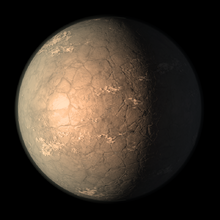
TRAPPIST-1g, also known as 2MASS J23062928-0502285 g, is a terrestrial extrasolar planet orbiting around the ultra-cold dwarf star TRAPPIST-1, located approximately 39 light-years (12 parsecs) away from Earth in the constellation Aquarius.
It was one of four new exoplanets to be discovered orbiting the star using observations from the Spitzer Space Telescope.
Characteristics[]
Mass, radius, and temperature[]
TRAPPIST-1g is an Earth-sized exoplanet, meaning it has a mass and radius close to that of Earth. It has an equilibrium temperature of 198.6 K (-75 °C; -102 °F). This planet has a mass of 1.34 Earth masses and a radius of 1.13 Earth radii, resulting in an estimated surface gravity of 10.3 m/s2 and a density of 5.13 g/cm3, both similar to Earth.
Host star[]
The planet orbits a (late M-type) ultra-cool dwarf star named TRAPPIST-1. The star has a mass of 0.089 Solar mass (M☉) and a radius of 0.121 Solar radii (R☉). It has a temperature of 2516 K and is anywhere between 3 and 8 billion years old. In comparison, the Sun is 4.6 billion years old and has a temperature of 5778 K. The star is metal-rich, with a metallicity ([Fe/H]) of 0.04, or 109% the solar amount. This is particularly odd as such low-mass stars near the boundary between brown dwarfs and hydrogen-fusing stars should be expected to have considerably less metal content than the Sun. Its luminosity (L☉) is 0.0522% of that of the Sun.
The star's apparent magnitude, or how bright it appears from Earth's perspective, is 18.8. Therefore, it is too dim to be seen with the naked eye.
Orbit[]
TRAPPIST-1g orbits its host star with an orbital period of about 12.353 days and an orbital radius of about 0.0451 times that of Earth's (compared to the distance of Mercury from the Sun, which is about 0.38 AU). This is in the outer limit of TRAPPIST-1's habitable zone. The orbit of TRAPPIST-1g has an eccentricity of 0.003, much lower than that of Earth and similar to that of TRAPPIST-1e. Its orbit varies by only about 41,000 kilometers (compared to about 5 million km for Earth), probably making the planet's climate very stable. It is in a 3:2 orbital resonance with TRAPPIST-1h and a 3:4 resonance with TRAPPIST-1f.
Water[]
On 31 August 2017, astronomers at the Hubble Space Telescope reported the first evidence of possible water content on the TRAPPIST-1 exoplanets.